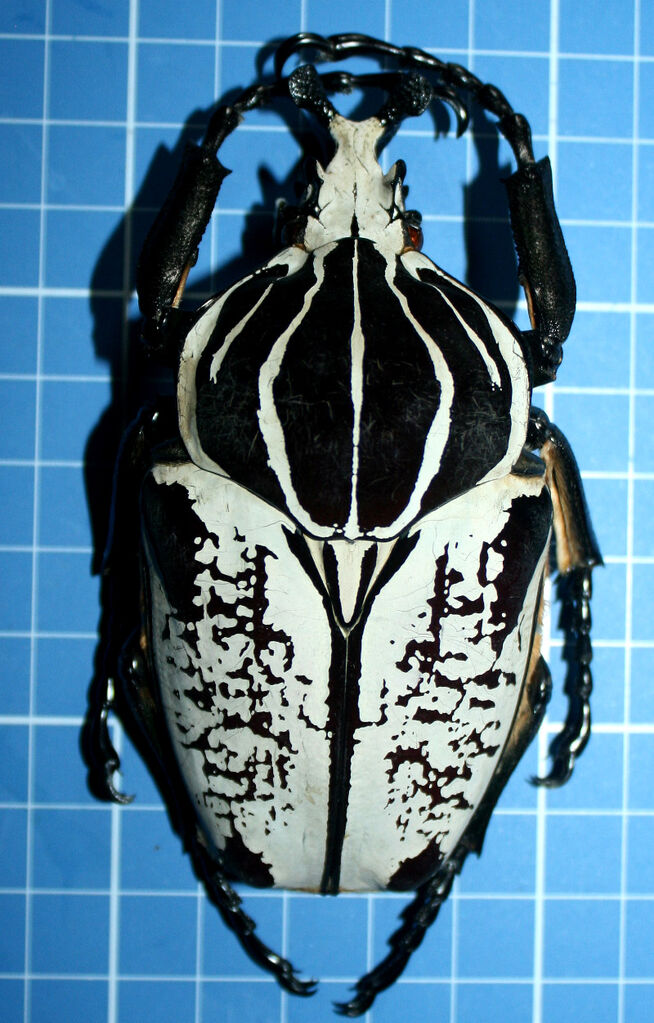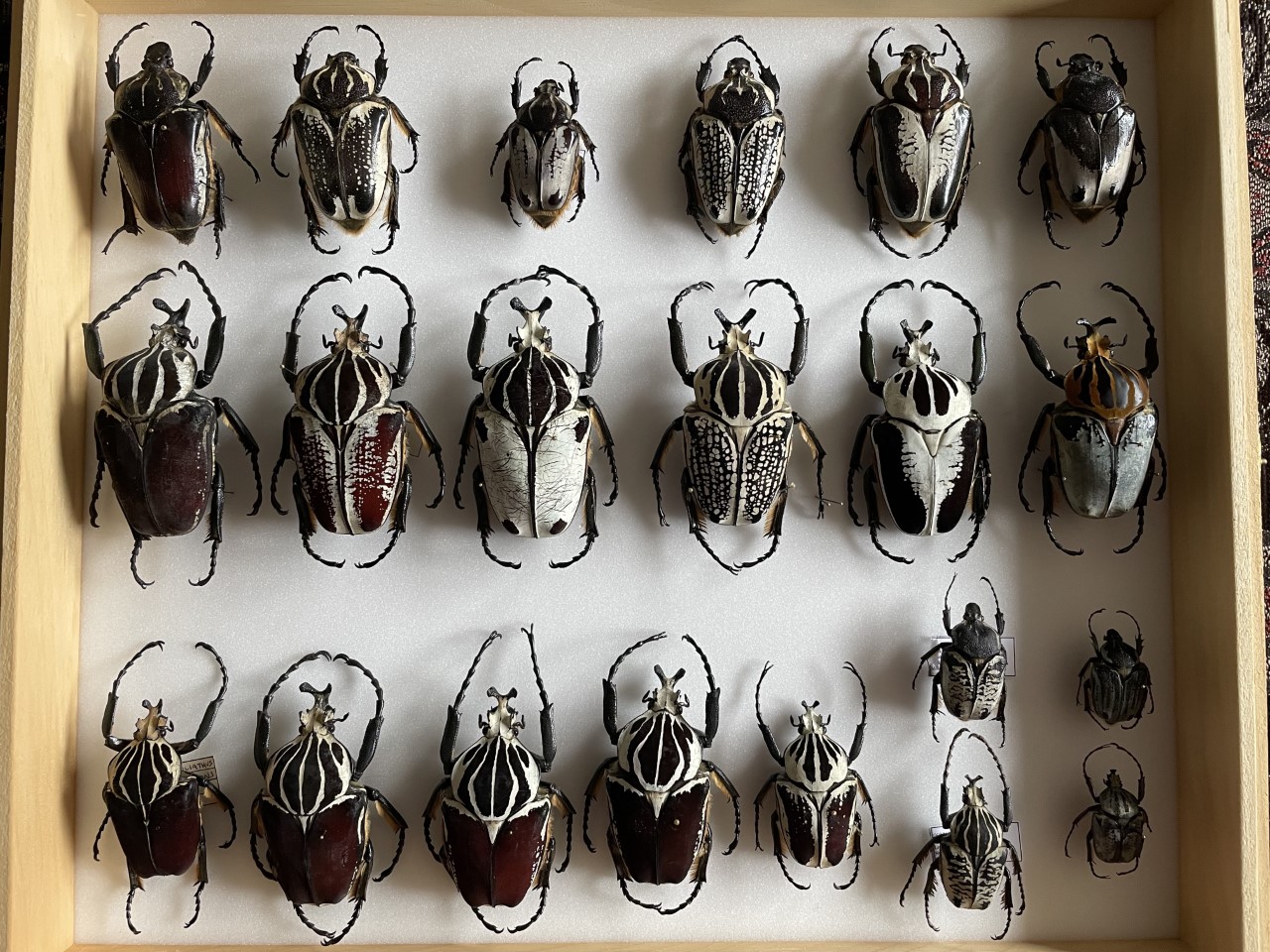|
|
Post by Paul K on Mar 5, 2021 8:10:31 GMT -8
I usually don’t by my specimens, but once for a while there is an urge for having something else that my availability to catch.
Goliath beetles are probably one of the most impressive Coleoptera genus with their size, colours and patterns and I would really like to have one or few in my collection. I will probably never travel to Africa ( unless hit the lottery jackpot) so I’m most likely looking to buy one of eBay or other source.
I would like to get an advice what species I should look for and I’m not talking about aberration or rare once that cost a lot, but some nice representation of genus.
Thanks in advance
Cheers
Paul
|
|
|
|
|
|
Post by kevinkk on Mar 5, 2021 8:39:04 GMT -8
I think there are five nominate species, if that's the correct terminology, and some have a lot of variation and are sometimes described as forms
or subspecies.
G. albosignatus, G.orientalis, G.goliatus, G.cacius, G.regius
I've noticed that orientalis has different variations, and it depends on the seller how they will list those.
Even though Goliathus goliatus has been raised in the USA legally for a few years, it is cheaper to buy dead ones.
When I look for something new, I'll look at ebay, simply because it comes with pictures, and you can get an idea of pricing, and what
seems typical.
|
|
|
|
Post by nomihoudai on Mar 5, 2021 9:53:57 GMT -8
I would have suggested to get a book on the topic and then decide, but while there is an extensive list of books on the genus Goliathus with a lot of pictures, the books are pretty expensive. I think just browsing eBay to see what is available in general will help. There isn't that many species in the genus Goliathus. There is a few related Goliathini that are very colorful. They are certainly interesting.
I once had Taurhina as pets. Don't know if the name is still up to date.
|
|
|
|
Post by livingplanet3 on Mar 5, 2021 10:25:12 GMT -8
Yes - 5 recognized species, as kevinkk listed. A 6th, G. "atlas", isn't considered an actual species, but a very rare variant of G. regius, or possibly, a hybrid between regius and cacicus (with which it is sympatric). If you want to put together a collection of Goliathus that displays considerable variation within a species, then G. orientalis and G. goliatus would be the ones to focus on, as variation within the other 3 species (regius, cacicus and albosignatus) is considerably less by comparison. G. goliatus has the widest distribution of any of the Goliathus species, with dozens of forms having been named. Among the most expensive of these, is G. g. quadrimaculatus, which is only found in one particular area of Cameroon. Extra large examples of this form in very fine condition can sell for upwards of $1000 USD. Another uncommon form of G. goliatus is hieroglyphicus - one of the seemingly endless variations in the elytral pattern in this species. Here's a photo of one of my specimens of hieroglyphicus -  |
|
pierre
Junior Member
 
Posts: 33
Country: Switzerland
|
Post by pierre on Mar 5, 2021 10:42:03 GMT -8
Having made a lot of trades with african collectors during these past 18 years (studies on african Callichromatini), I have recieved quite a lot of wild cought Goliathus in the parcels. Goliathus are mostly common except for some variants. But highly commercial. This pushes up the prices, sometimes beyond any reasonable level.
If you would like to get some specimen for your collection, I would share with pleasure. I don't look for money; perhaps something to exchange?
pierre.haller@greenmail.ch
|
|
|
|
Post by africaone on Mar 5, 2021 11:49:56 GMT -8
The systematic has been recently reviewed ... see the site of Entomologia Africana SEA entomologia africana revuego to summary section and the pdf is available (downloadable) in volume 25 1 |
|
|
|
|
|
Post by alandmor on Mar 5, 2021 12:24:02 GMT -8
A nice graphic showing Goliathus species and their distribution:  |
|
|
|
Post by trehopr1 on Mar 5, 2021 12:25:56 GMT -8
Indeed Paul, see what pierre can offer you first.
Goliathus are of a cult status amongst many beetle enthusiasts.
Though limited in actual species (as mentioned above); two of them
orientalis (formerly meleagris) and goliathus each offer a fair amount
of variation in color and especially markings...
I have seen G. goliathus run the gamut of color from overall black looking
males to ones appearing very much reddish throughout. And then, they "spin
off on a tangent" with variants like the above one in black/white.
The Atlas versions have almost entirely white elytra and are seldom offered.
Keep in mind Paul K the idea of size. Basically, any male running (near) or over
100 mm. is a large (major) male with a well developed frontal face horn. A 90-96-ish
sized male is still descent but, anything under 90 is considered medium sized or
even (small) for these guys with of coarse -- a correspondingly sized smaller AND
(less robust) frontal face horn.
Additionally, you will also want to get a specimen(s) which is CLEAN and free (or
largely free) of any apparent scratches, body damage, body "rubs" or anything else
affecting the overall clean appearance of a good specimen.
Battle damage and the look of a life (well spent) generally do not bode well
in their pricing. These are automatically relegated to A2 status or worse...
Also, females generally have little net worth or meaning as all the real value
and or flash/bang (bling) centers on the males.
I "dabbled" in these briefly so I know a thing or two about the crazy market for these
and the nuances of getting choice specimens.
Just tread "lightly" and walk smartly and you will get something nice in
representation for your collection !
|
|
|
|
Post by exoticimports on Mar 5, 2021 13:01:02 GMT -8
Funny thing about Golaithus, what used to be expensive isn't, and what used to be cheap, isn't.
Albosignatus were over $250 when they first flooded the commercial market, now they're $35.
The forms (apicalis, etc.) were stupid expensive, and now they're not.
Quadrimaculatus prices are insanely high.
You pay for size, and you pay for perfection. Backing off from huge and perfect can halve the price.
Best place to buy are insect shows, where many dealers have many specimens. Not sure when the next show in Canada is though.
Ebay is a good place to get them, EXCEPT for the rarer forms/ sizes.
My two opinions: (1) don't get a tiny one, get something at least 80mm otherwise they LOOK tiny (2) if you get G goliatus, get one with the reddish/maroon color rather than the dark brown, they just look a heck of a lot more impressive.
Chuck
|
|
pierre
Junior Member
 
Posts: 33
Country: Switzerland
|
Post by pierre on Mar 6, 2021 1:16:56 GMT -8
Everything trehopr1 and exoticimports say is right. Unfortunately. Reflecting exactly the nowadays attitude where everything has to be large and perfect, the rest not being worth even to be looked at.
Paul, sorry but I certainly am not able to satisfy these criteria.
|
|
|
|
Post by africaone on Mar 6, 2021 2:40:59 GMT -8
Strange to see some comments about the market.
Anynone can spend his money as he wish and if high prices occurs it is their problem.
Science has nothing to do with that (some arguments we seen ofetn are quite hypocrits about that), it is a commercial matter.
Africa has very few pricy species comparing Asia and South America where millions dollars are spent. Such market allows some natives to live and obtain few money to pay school, medical or food, etc. Internet changed quite a lot the circuit and allow locals to be better paid.
Goliath (sensu lato) are of the few African insects having a large range of WW customers (as a few Charaxes and Papilio, the Big Five + few cases as hayesii) all others are for a very confidential and limited market.
|
|
|
|
Post by africaone on Mar 6, 2021 7:34:17 GMT -8
A nice graphic showing Goliathus species and their distribution:  Nice map and picture but the situation changed very much. This map is old, not updated. Zaire is no more this name from 1997, no indication about the Tanzanian endemic G. orientalis (confused with meleagris in the past), goliatus is known from Benin, cacicus and regius are not known eastern Dahomey gap, etc. An update has been welcome |
|
|
|
Post by alandmor on Mar 6, 2021 10:00:02 GMT -8
Nice map and picture but the situation changed very much.
This map is old, not updated. Zaire is no more this name from 1997, no indication about the Tanzanian endemic G. orientalis (confused with meleagris in the past), goliatus is known from Benin, cacicus and regius are not known eastern Dahomey gap, etc.
An update has been welcome.
Thanks for the clarification.
|
|
|
|
Post by exoticimports on Mar 6, 2021 11:00:43 GMT -8
I keep a drawer of Goliathus for displays at educational events. This assembly started about 1976, and the latest specimen added last year, so it was a very long, patient search.  |
|
|
|
Post by Paul K on Mar 6, 2021 11:40:16 GMT -8
Very impressive drawer, thanks for sharing Chuck.
|
|